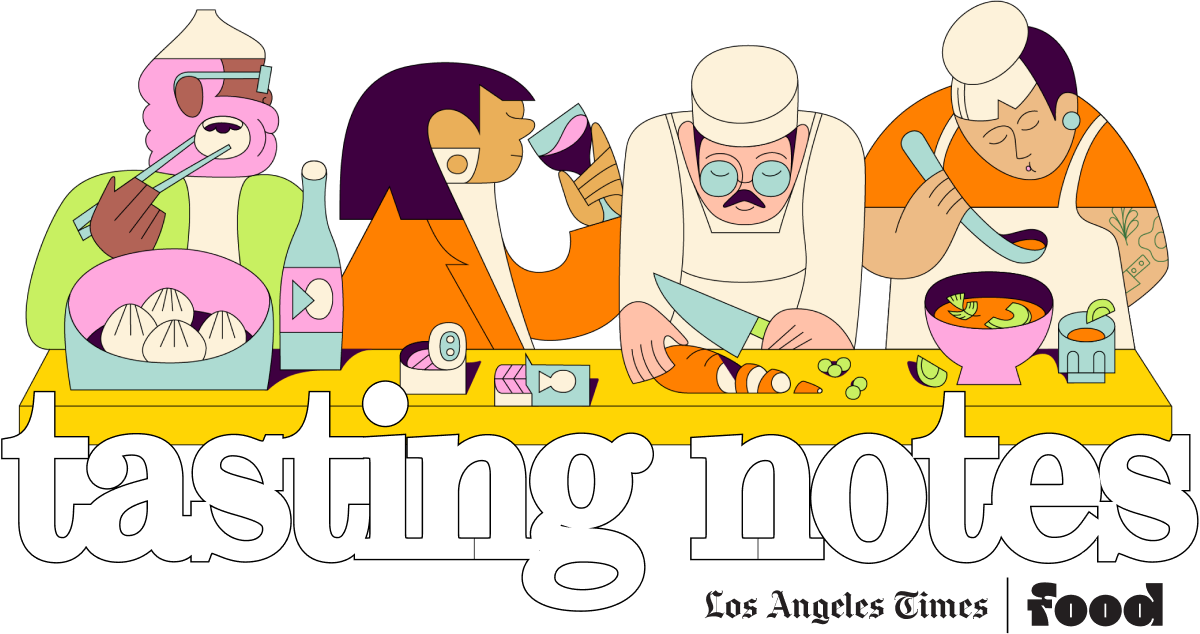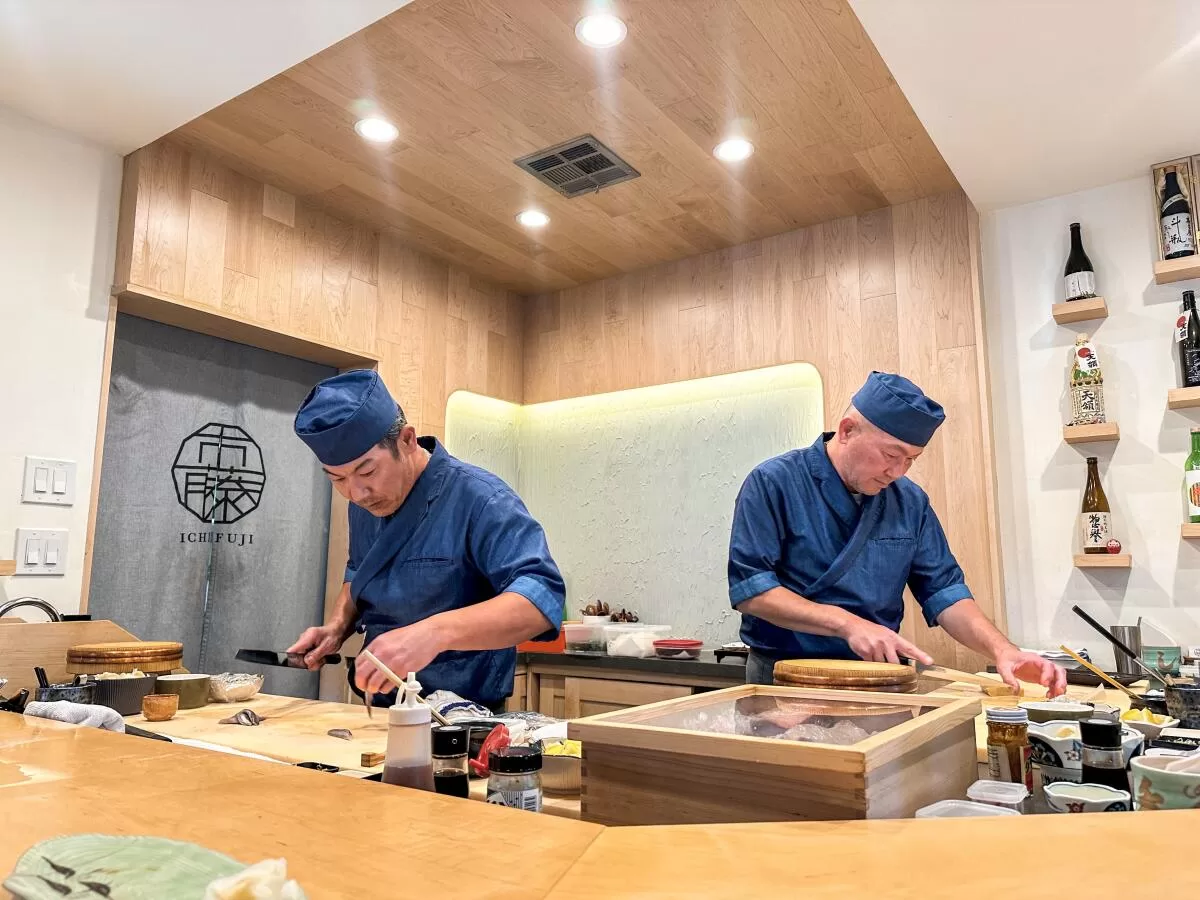The great thing about dining at sushi counters, beyond close communion with the chef, is the conversations that often spark between customers about all kinds of restaurants.
Last month I was having dinner at Ichifuji, a restaurant in the Linda Vista neighborhood of San Diego — on assignment to write a fresh guide to eating and drinking in the city. Ichifuji’s 10-seat counter resides in a squat, nondescript building. At the entrance you’ll see a gate, part sculpture and part security, made from thick metal bars, imposing save for the white noren (Japanese door curtains) that herald you’re in the right place.
Inside, owners Hiroshi Ichikawa and Masato Fujita have created a welcoming cocoon. They’re friendly and talkative with diners while staying focused on serving omakase. In matching blue uniforms, Ichikawa crafts nigiri and sashimi for those seated on the left half of the room, while Fujita handles the right-hand side.
Where a sushi bar convo can lead you
Around the time Ichikawa was handing my partner and me pieces of nodoguro lightly blazed with a blowtorch, a local real estate professional named David Hussain settled in next to us. Before long he knew we were visiting from Los Angeles. The subject of coffee in San Diego came up, and he recommended a shop called Finjan (“coffee cup” in Arabic), where baristas make drinks from beans roasted by James Coffee Co. and serve Palestinian-style knafeh and baklava for dessert.
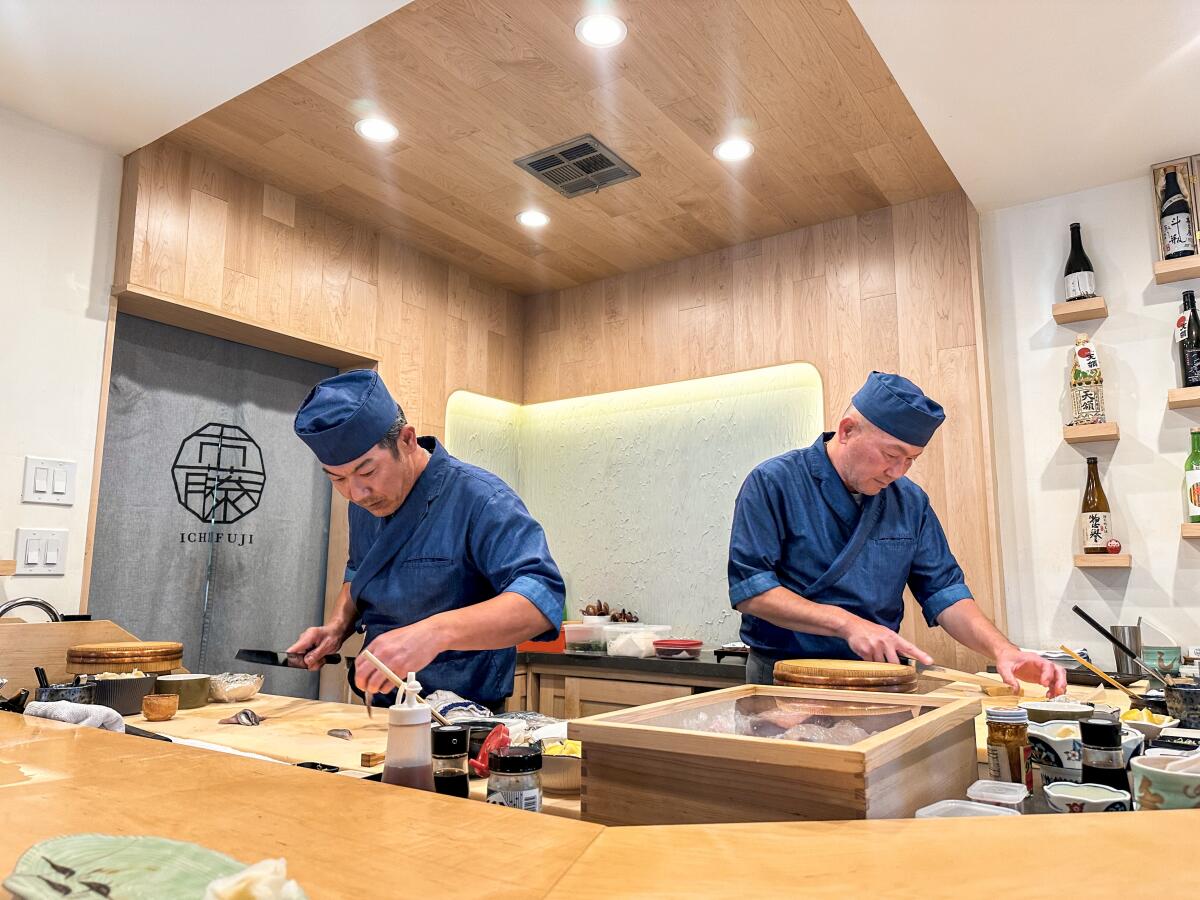
Hiroshi Ichikawa and Masato Fujita stand at the bar of their San Diego sushi restaurant Ichifuji.
(Bill Addison / Los Angeles Times)
I told Hussain that he was talking in the vicinity of some of my favorite cuisines in the world, so he lobbed out another suggestion: Mal Al Sham. It’s a Syrian restaurant in El Cajon, a small city about a 20-minute drive from downtown San Diego that has become home to one of the country’s largest Iraqi immigrant and refugee communities. I felt grateful. None of this had been on my research radar.
On Sunday a few days later, as a last stop before heading back to L.A., we drove down East Main Street in El Cajon. Signs identified one Iraqi restaurant after another: Ali Baba, Nahrain, Sagmani’s, Al Rafidain, Al Azayem. Los Angeles has few places to become acquainted with Iraqi cuisine; I reviewed Akkad in Glendale in 2018, and have revisited specifically for breakfast and the hot pastry called kahi dolloped with melting clotted cream.
Promising myself I’d return to El Cajon soon to dive deeper into its Iraqi riches, I pulled into the parking lot of Mal Al Sham.
Poking around online, I’d seen pictures of customers ordering mansaf, the Bedouin feast of spiced lamb laid over flatbread and rice. Its silken sauce must have a crucial ingredient: jameed, dried and reconstituted yogurt that adds a distinct, delicious sharpness. Mansaf is most closely associated with Jordan but loved throughout the region. Palestinian cookbook author Reem Kassis has noted that Arabic culinary texts from as far back as the 10th century notate variations of the dish.
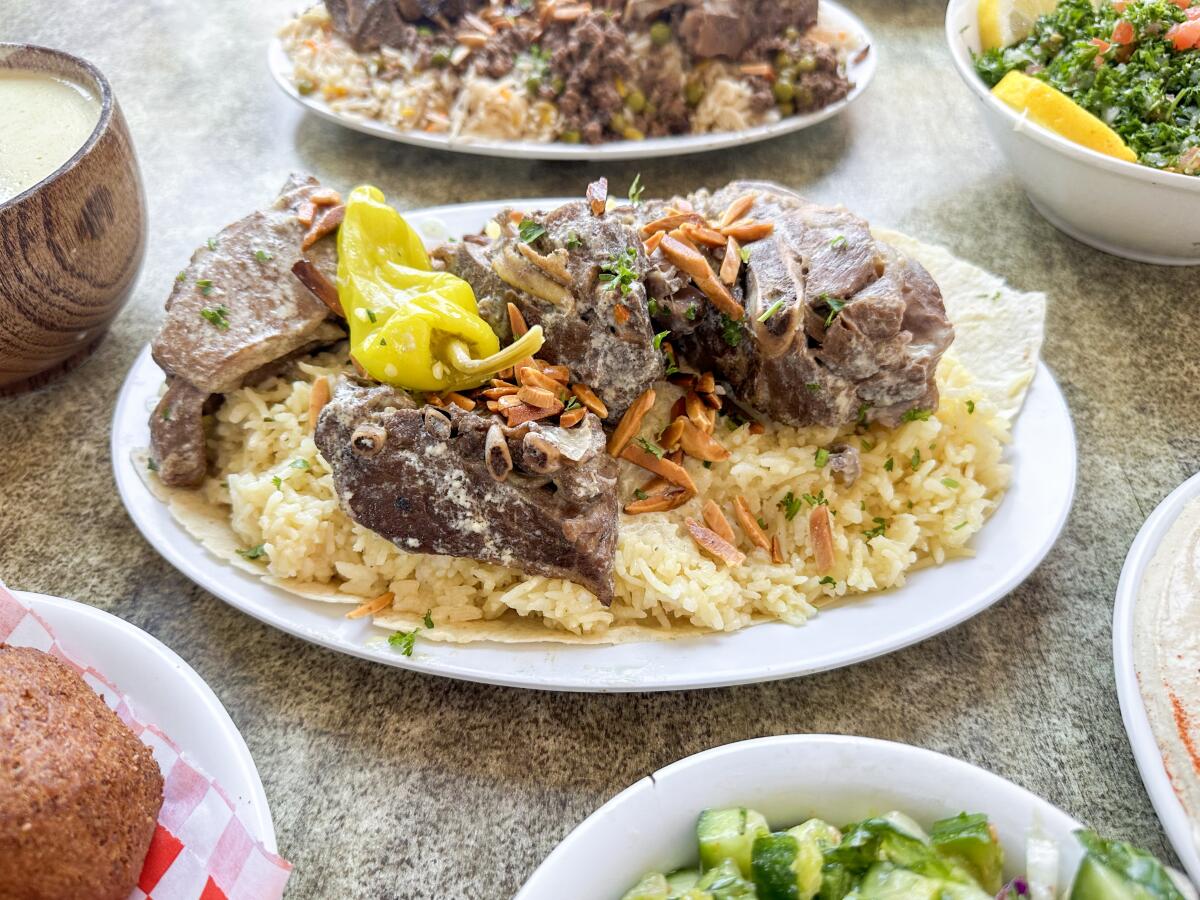
Mansaf, a standout dish at Syrian restaurant Mal Al Sham in El Cajon.
(Bill Addison / Los Angeles Times)
The version at Mal Al Sham can help you understand why mansaf has endured for more than a millennium. It isn’t listed on the menu, but when I asked a server about it, she didn’t blink: Yes, mansaf was available, and among orders of hummus, tabbouli, fried kibbeh, falafel and fattoush, it was the first platter to arrive. A generous bowl of yogurt sauce appeared alongside, charged with the taste of jameed. I’ve had a difficult time finding the dish in Los Angeles-area restaurants. Ammatoli in Long Beach sometimes serves it for brunch. This one made me very, very happy.
I’ll also note that the restaurant honors the local Iraqi population by preparing a weekend special of quzi, another lamb and rice dish more vigorously seasoned with sweet, bright spices (but no yogurt sauce). It might be a lot of rice at one lunch, but I learned the next day that both reheat well.
Not every place I ate across San Diego made it onto my new guide of nearly two dozen standouts. Ichifuji and Mal Al Sham most certainly did.
Way more than a “brunch restaurant”
So did Atelier Manna, a daytime restaurant I was urged to try by Candice Woo, editor of Eater San Diego (and my former colleague). Candice knows more about dining in her hometown than anyone I’ve met. We’ve been sharing meals for a decade. She knew I would appreciate the caliber of cooking at Manna.
After Andrew Bachelier left heralded Jeune et Jolie in Carlsbad early in the pandemic, he returned to the scene in April 2023 with this small, open-air project in Leucadia, a community that’s part of Encinitas.
If you are completely agnostic on the subject of French toast, as I am, Bachelier’s take might turn you. He saturates a 3-inch-tall block of sourdough with strawberry custard, so the crust is crackling enough to require a knife yet the interior is almost molten, texturally between a soufflé and bread pudding. It could be scooped out with a spoon. Sliced strawberries and lemon verbena buds dot the top, and toasted coconut manages to come off as subtle amid the cacophony of flavors. It’s beautiful, but more importantly it is wildly satisfying.
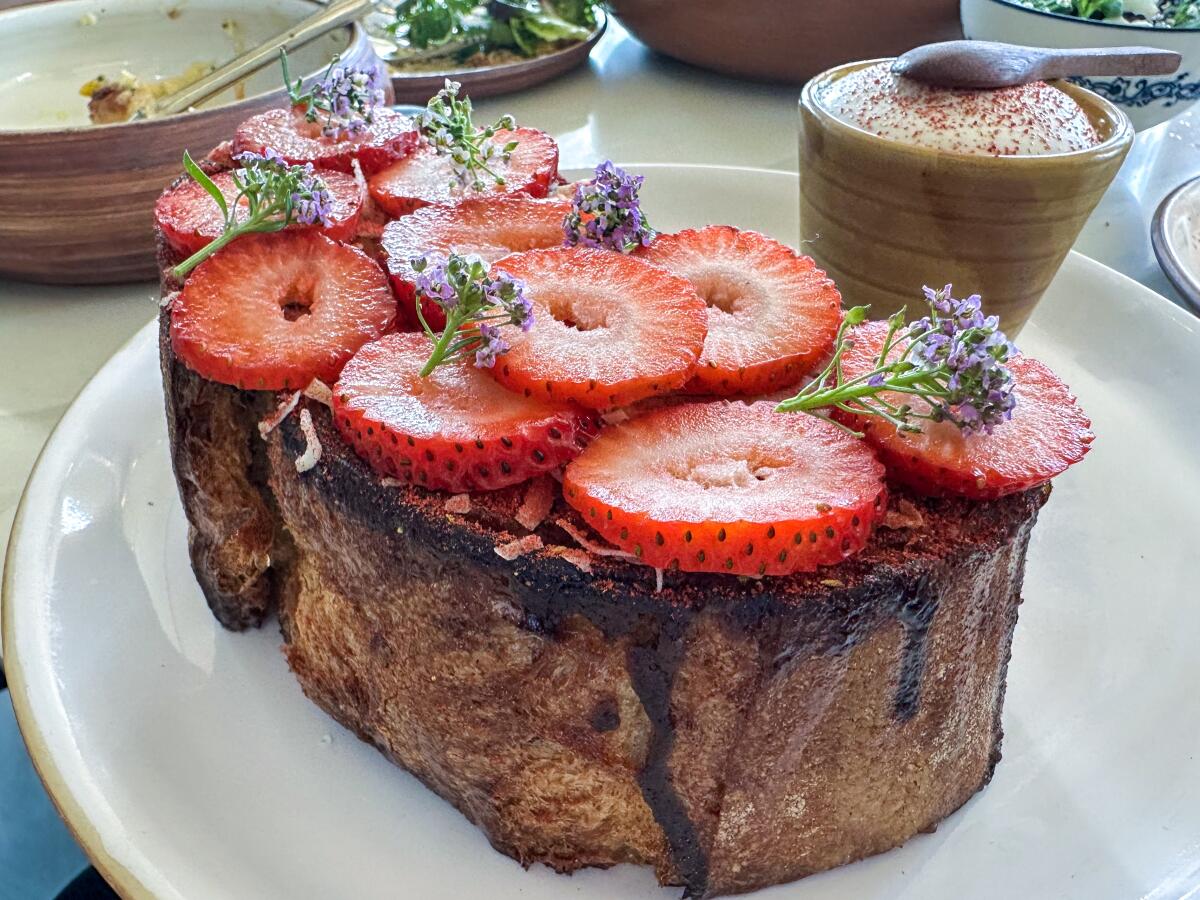
French toast, soaked in custard and crowned with strawberries, at Atelier Manna.
(Bill Addison / Los Angeles Times)
Most everything else on the menu leans savory: a take on Turkish eggs gilded with garlicky yogurt and chile-garlic butter and blanketed with soft herbs; scallops sinking into a quicksand of grits with summery succotash made with grilled corn; a wobbly hunk of pork collar surrounded by ripe slivers of stone fruit.
And to drink? Some of the smartest nonalcoholic concoctions to be found in Southern California. Beverage director Nick Sinutko calls them “vitality tonics.” Mixing flavors like mulberry, lemon, jasmine and (winningly) chervil, he steeps ingredients into teas and infusions and brews acid solutions out of citrus. He manages the elusive trick of giving body to combinations that could wind up tasting of fancy juice. His efforts remind me of Han Suk Cho and Austin Hennelly’s n/a cocktails at Kato.
I will just say it: I wish Manna were in Los Angeles. The restaurant operates Wednesday through Sunday. It merits braving traffic for a day trip. Other restaurants around San Diego do, too. Please check out the guide.
Newsletter
You’re reading Tasting Notes
Our L.A. Times restaurant experts share insights and off-the-cuff takes on where they’re eating right now.
You may occasionally receive promotional content from the Los Angeles Times.
Also…
- More from the San Diego area: For this week’s review (and in tandem with the Times’s project on the state’s best beaches), I write about Baja chef Roberto Alcocer’s globally influenced, modern Mexican tasting menu at Valle in Oceanside.
- On the heels of the Food team’s massive Tacos 101 guide — you saw it? — columnist Jenn Harris advocates for a style we didn’t directly detail on the list: wet tacos.
- Stephanie Breijo writes about the life of Steven Arroyo, the prolific restaurateur behind Cobras & Matadors, Church & State, Escuela Taqueria, Malo, Boxer, Burger She Wrote, Cobra Lily and Potato Chips Deli. He died at age 55 on Sunday due to medical complications from cancer treatment.
- Stephanie also has the details on Camélia, the new French-Japanese Arts District restaurant from Tsubaki owners Courtney Kaplan and Charles Namba.
- Grace Xue visits the first U.S. location, in Beverly Hills, of one of China’s trendiest tea stores.
- With a pandemic-era program extended, Cindy Carcamo addresses the question: Did Mayor Karen Bass just save outdoor dining in L.A.?
- Kelly Dobkin has nine suggestions for Korean-owned coffee shops making lattes with an exceptionally comforting ingredient: misugaru.
- Finally, on the political front, Daniel Miller wonders: Will Kamala Harris’s love of cooking and knowledge of L.A. restaurants help her win the election?
